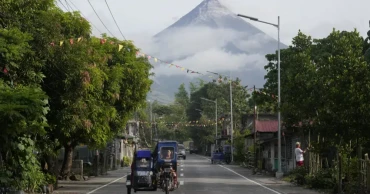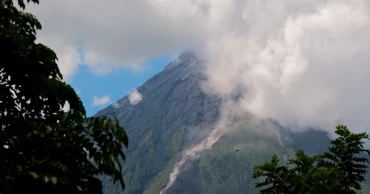Mayon Volcano
Philippine villagers flee ashfall, sight of red-hot lava from erupting Mayon volcano
Truckloads of villagers on Tuesday fled Philippine communities close to the erupting Mayon volcano, traumatized by the sight of red-hot lava flowing down its crater and fearful of sporadic blasts of ash.
Nearly 15,000 people have left the mostly poor farming communities within a 6-kilometer (3.7-mile) radius of Mayon's crater in northeastern Albay province in forced evacuations since volcanic activity spiked last week. Albay's governor extended the danger zone by a kilometer (more than half a mile) on Monday and asked thousands of residents to be ready to move anytime.
Also Read: Philippines’ Mayon Volcano spews lava down its slopes in gentle eruption putting thousands on alert
But many opted to flee from the expanded danger zone even before the mandatory evacuation order.
"There's lava and ashfall already," Fidela Banzuela, 61, said from a navy truck where she, her daughter, grandchildren and neighbors clambered up after leaving their home in San Fernando village close to Mayon. "If the volcano explodes, we won't see anything because it would be so dark."
Her daughter, Sarah Banzuela, fled with her two children, including a 2-year-old who has asthma, which she said could be triggered back by volcanic ash that rained down on their village over the weekend.
Also Read: Philippines evacuates people near Mayon Volcano, where more unrest indicates eruption may be coming
"There's ashfall already and, at night, there's red-hot lava from the volcano that seems to be moving closer to us," Sarah Banzuela, 22, told The Associated Press. She and her mother arrived at a grade school turned into an evacuation center teeming with other displaced villagers.
After days of showing signs of renewed restiveness, including a swarm of rockfalls and a bright-orange crater glow visible at night, Mayon began expelling lava Sunday night, which flowed slowly down two gulleys on its southeastern slope, government volcano experts said.
An ash plume that shot up to 328 feet (100 meters) at dawn on Tuesday drifted southeastward with the wind toward some villages, said Teresito Bacolcol, director of the Philippine Institute of Volcanology and Seismology.
Also Read: Philippines warns of possible flooding, landslides as Typhoon Mawar slowly passes to north
An AP video showed a boulder getting ripped from the side of a dome of lava in Mayon's crater then plunging and breaking into smaller red-hot pieces as it rolled down and smashed onto other stones on the volcano's steep slope.
The 2,462-meter (8,077-foot) Mayon is a top tourist draw in the Philippines because of its picturesque conical shape but is the most active of 24 known volcanoes in the archipelago. It last erupted violently in 2018, displacing tens of thousands. In 1814, Mayon's eruption buried entire villages and left more than 1,000 people dead.
With its peak often shrouded by wisps of passing clouds, Mayon appeared calm on Tuesday, but Bacolcol told AP that lava was continuing to flow slowly down its slopes but could not easily be seen under the bright sun.
The volcano had been raised to alert level three on a five-step warning system last Thursday, meaning a hazardous eruption is possible in weeks or days.
The eruption is the latest natural calamity to test the administration of President Ferdinand Marcos Jr., who took office in June last year and inherited an economy that was shattered by two years of the coronavirus pandemic, which also deepened poverty and unemployment. He has deployed some of his Cabinet officials to Albay to help distribute food aid to and reassure displaced villagers.
Liza David Balbin fled with her children to an emergency shelter in Santo Domingo town after she got scared of Mayon's lava emissions and her farming community of San Antonio was hit by ashfall. The 48-year-old housewife said the government should find an effective way of relocating poor Filipinos like her away from volcanoes, mountainsides where landslides are common and coastlines that are lashed by tidal waves.
In 1991, Balbin witnessed Mount Pinatubo blowing its top in one of the biggest volcanic eruptions of the 20th century. The massive ashfall and volcanic mudflows wiped out her village and outlying communities in Pampanga province north of Manila. She survived and years later married a man who took her to his home province of Albay, where they lived in an impoverished village not far from Mayon.
"I escaped from Pinatubo then ended up near Mayon volcano," she told AP with a laugh. "Why is my life like this?"
"If only we've got money, we would have left that danger zone and built a house far away," said Balbin, who makes a living doing laundry. "Now we're in an evacuation camp again and it's really been a difficult life. This is too much."
2 years ago
Philippines’ Mayon Volcano spews lava down its slopes in gentle eruption putting thousands on alert
The Philippines' most active volcano was gently spewing lava down its slopes Monday, alerting tens of thousands of people they may have to quickly flee a violent and life-threatening explosion.
More than 12,600 people have left the mostly poor farming communities within a 6-kilometer (3.7-mile) radius of Mayon Volcano's crater in mandatory evacuations since volcanic activity increased last week. But thousands more remain within the permanent danger zone below Mayon, an area long declared off-limits to people but where generations have lived and farmed because they have nowhere else to go.
With the volcano beginning to expel lava Sunday night, the high-risk zone around Mayon may be expanded should the eruption turn violent, said Teresito Bacolcol, director of the Philippine Institute of Volcanology and Seismology. Bacolcol said if that happens, people in any expanded danger zone should be prepared to evacuate to emergency shelters.
Also Read: Philippines evacuates people near Mayon Volcano, where more unrest indicates eruption may be coming
2 years ago
Philippines evacuates people near Mayon Volcano, where more unrest indicates eruption may be coming
Philippine troops, police and rescue workers began forcibly evacuating residents near Mayon Volcano on Friday as its increasing unrest indicated a violent eruption of one of the country's most active volcanoes is possible within weeks or days.
The area within a 6-kilometer (3.7-mile) radius of Mayon's crater is supposed to be off-limits due to possible volcanic emissions, lava flows, rockfalls and other hazards. But many poor villagers have built houses and tended farms in Mayon's danger zone over the years.
President Ferdinand Marcos Jr. said an evacuation of residents from the permanent danger zone was underway and promised to provide aid to the displaced until the crisis ended.
Also Read: Philippines warns of possible flooding, landslides as Typhoon Mawar slowly passes to north
"Right now, what we are doing is preparing and moving people away from the area so that, should the time come, I hope it doesn't happen…we're ready," Marcos told reporters. "But unfortunately science tells us that may happen because the lid or the cap on top of the lava is slowly rising."
Authorities had raised the alert level for the volcano in northeastern Albay province Thursday after superheated streams of gas, debris and rocks cascaded down its upper slope, indicating activity below the surface that could precede a hazardous eruption.
Conditions have advanced a little bit more Friday, although lava hasn't started to flow, Marcos said.
The numbers of residents being evacuated weren't immediately available.
A tourist draw for its picturesque conical shape, 2,462-meter (8,077-feet) Mayon last erupted violently in 2018, displacing tens of thousands of villagers.
Government volcano experts raised the alert level around Mayon to the third of a five-step warning system Thursday after detecting an increasing number of rockfalls and at least two volcanic earthquakes in recent days.
Six brief volcanic gas and ash emissions streamed down the volcano's southern gullies about 2 kilometers (1.2 miles) from the crater Friday. Numerous rockfalls and thin ash and steam plumes that drifted south were also observed, the government volcanology institute said.
Mayon is at "a relatively high level of unrest as magma is at the crater and hazardous eruption is possible within weeks or even days," the institute said in its latest update Friday morning.
Mayon is one of the most restive of two dozen active volcanoes across the Philippines.
Officials also were closely monitoring Taal Volcano south of Manila and Mount Kanlaon on central Negros island due to renewed signs of restiveness.
A number of villages in three towns near Taal suspended classes Wednesday due to thick smog emanating from the volcano and residents were advised to limit outdoor activities and wear masks for protection.
The Philippines lies along the Pacific "Ring of Fire," the area around the ocean rim where tectonic plates meet that is prone to earthquakes and volcanic eruptions. A long-dormant volcano, Mount Pinatubo, blew its top north of Manila in 1991 in one of the biggest volcanic eruptions of the 20th century, killing hundreds of people.
2 years ago





